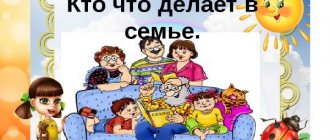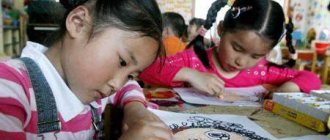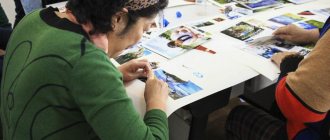Psychological training with teachers “Together a friendly family”
Author: Khegetyan Alina Danielovna
Psychological training with teachers
"Together a friendly family."
Purpose of the training:
- team building and building effective team interaction.
Training objectives:
- formation and strengthening of a common team spirit by uniting a group of people;
- development of responsibility and contribution of each participant to solving common problems;
- awareness of oneself as a team.
Progress of the training:
Stage 1.
1.1.Acquaintance
— Hello, dear colleagues, today we will take part in a training called “I + YOU = WE.” The purpose of the training is to unite the team and build effective team interaction.
1.2. Every training has rules. Let us also develop our own rules...
- Here and now (during the training we only talk about what worries everyone right now, and discuss what is happening to us right here).
- I speak for myself.
- Listen carefully to each other.
- Don't interrupt the speaker.
- Respect each other's opinions.
- Non-judgmental judgments.
- Activity.
- “Stop” rule, stopping the discussion at the coach’s “stop” signal.
- Confidentiality (everything that happens here is not shared outside the group under any pretext).
1.3.MY NAME IS... I DO THIS....
Purpose: acquaintance, relief of anxiety, promotes memorization of names.
The exercise can be done sitting or standing. Each participant in a circle says his name and shows some kind of movement with the words: “I do this...”. Each subsequent participant first repeats all the names and movements of the previous ones, and then calls his name and shows his movement. Thus, the last participant must repeat the names and movements of all other group members.
Stage 2. Information
2.1.Dear colleagues, what do you think the word “unity” means? Unity is an opportunity to become one to achieve specific goals and objectives. After all, how good it is when your colleague understands and supports you, how good it is to hear and help when this help is needed, how well to understand each other even without words. A close-knit team achieves many peaks and victories.
Cohesion is:
- coincidence of interests, views, values and orientations of team members;
- an atmosphere of psychological safety, goodwill, acceptance;
- active, emotionally rich joint activity aimed at achieving a goal that is significant for all participants.
Stage 3 Warm-up
3.1.WE ARE SIMILAR IN THE THINGS THAT...
Goal: removing aggression.
When throwing the ball to any person, we call him by name and say: “You and I are similar in that...”. (For example: that we live on planet Earth, we work in the same team, etc.)
Discussion:
- What emotions did you experience during the exercise?
- What new things have you learned about others?
- What interesting things did you find out?
3.2.YES AND NO
Goals: removal of aggression, readiness to communicate.
- Break into pairs and stand opposite each other. Decide who in your couple wants to say “Yes” and who wants to say “No”. One of you starts the game by saying the word “Yes.” The second one immediately answers him: “No!” Then the first one says again: “Yes!”, perhaps a little louder than the first time, and the second one again answers him: “No!”, and also a little louder. Each of you must say only the word he chose from the very beginning: either “Yes” or “No.” But you can pronounce it in different ways: quietly or loudly, gently or rudely. You can have a nice little argument with these two words if you want, but it's important that no one is offended in any way. After some time, I will give you a signal that it is time to end the “dispute.”
Discussion:
- How are you feeling now?
- How do you prefer to argue - by saying the word “Yes” or by saying the word “No”?
- Did you speak loud enough?
Stage 4: Practical
4.1. Association test "Magic dream"
To take the test you will need a piece of paper and a pen.
Description:
We invite you on an enchanting journey through your soul.
All people see dreams, and it’s no secret that dreams are our subconscious, which never lies and often knows more about ourselves than we do ourselves. But not all people remember their dreams, and not everyone knows how to interpret what they see in their dreams.
We invite you to play associations, immerse yourself in a dream and describe in detail what you see.
Instructions:
Imagine yourself in the situations that will be offered to you, and then describe “what you saw” when answering the test questions. To make it easier to decipher the results, write down your answers on a piece of paper.
Test:
You are sleeping or dreaming. In your dream you find yourself in your own home. What is he like? Describe in detail. (Large/small, light/dark, old/new, how many rooms)
Now you are walking along a narrow path. Suddenly you see a vessel on the ground in front of you. What it is? What is inside? If there is something inside, then taste it. What is it like?
And now the path ends and you enter the forest. You walk for quite a long time and finally come out into a clearing. There is a building in the middle of the clearing. What kind of building is this? How do you feel in this place?
There is a garden around the building. Describe the garden. What is he like? Blooming or withered?
You leave the garden and walk through the forest again. At the edge of the forest you see a wall. The wall is so high that you can’t climb it, and so long that you can’t go around it. Suddenly you see a small door in the wall that opens slightly, as if inviting you to enter. Will you come in or not?
And behind the wall there is water. What kind of water is this? (Which body of water? Is it calm or rough water?) Do you want to swim in it?
Well, now read the Interpretation and good luck to you!
Interpretation of test results:
House.
Home is a representation of yourself.
If the house is old, then most likely you do not like to change, you prefer traditional things.
If the house is large, then this means that he is a fairly confident person with high self-esteem.
If the house is bright, then you are an optimist. If he is dark, then he is a pessimist.
The number of rooms is the number of people you would like to see in your life.
Vessel.
The vessel is your idea of love. The more beautiful and valuable the vessel, the more significant the love in your life. You are a romantic person. The contents of the vessel are your love experience.
Building.
The building is your idea of religion and God.
A strong building means a strong faith.
Destroyed building - Your faith is weak.
Garden.
This is your idea of the world around you, your country, the world in general. If the plants and flowers in the garden are dying, this may mean that you are concerned about the state of the environment and the future of the world.
Wall.
This is your idea of death. Is this the end or is there life after the death of the physical body? Will you go through this little door? Or will you look and check what's there first before entering? Or do you not want to enter at all?
Water.
Water is your idea of your future. If this is a sea with big waves, then you are confident and not afraid of your future.
If you want to swim, it means that you are not afraid to face possible difficulties.
If the water is a body of standing water, then perhaps you are afraid of your future and fear for the future of the whole world
4.2. Breathing exercise SEVEN CANDLES
Goal: relaxation.
- Sit comfortably, close your eyes, relax. You are calm, comfortable and comfortable... You breathe deeply and evenly... Imagine that there are seven burning candles at a distance of about a meter from you... Take a slow, as deep breath as possible. Now imagine that you need to blow out one of these candles. Blow as hard as possible in its direction, exhaling completely. The flame begins to tremble, the candle goes out... You again take a slow, deep breath, and then blow out the next candle. And so all seven..."
The exercise is best performed with calm, quiet music in a semi-darkened room.
Discussion:
- How did the participants' condition change as they completed this exercise?
- Where in real life situations might such a technique be useful?
Stage 5. Final
5..1 Relaxation. Power of Life and Health
Please sit down more comfortably. Feel the support under you, every point of contact with the support. Feel the back of the chair (chair) on which you can lean. Place your feet more comfortably. Feel the floor with your feet. Position your arms more comfortably (feel the armrests). Position your neck and head so that it is comfortable and pleasant for you to imagine the images. Please close your eyes and try to relax. Relax, relieve the accumulated tension, as if you would like to take a little nap. Start relaxing with your shoulder muscles. Try to feel your shoulders becoming heavy, warm and relaxed. The shoulders are heavy and warm. Heavy and warm. Imagine how pleasant warmth spreads from your shoulders throughout your entire body. Feel how the warmth descends from your shoulders to your arms. The upper part of your arms relaxes. Your elbows relax Your wrists relax Your hands relax – your palms become heavy and warm. Your palms become heavy and warm. Heavy and warm. Every finger on your hands relaxes. Your hands are relaxed, sagging, right down to the very tips of your fingers. Now pay attention to how you breathe - your breathing becomes free and even, free and even. You breathe well and pleasantly. Try to feel a pleasant warmth in your chest, warmth in the solar plexus area , warmth in the belly. Imagine how the warmth from the belly goes down to the legs. Feel how the upper legs relax, the knees relax, the shins relax. The feet become heavy and warm. Feet are heavy and warm, heavy and warm. Feel your heels. Toes. All legs are relaxed. Now pay attention to your back. Feel how your lower back relaxes, feel your spine. Feel the shoulder blades. Feel how the middle of the back relaxes between the shoulder blades. The neck and back of the head relax. The whole head is relaxed. The crown and temples are relaxed. The forehead and face relax. Feel your cheeks, feel your cheekbones, chin. The lower jaw becomes heavy. The lips are relaxed, the tongue is warm, the nose and eyes relax. The eyelids become heavy, the eyelashes stick together. The eyes are relaxed.
Imagine a clear summer day. You are on the seashore. Your feet feel the warm soft sand. Gentle turquoise waves rustle at your feet, inviting you to follow them.
You enter the clear, warm sea water and feel how it caresses your body. The pleasant energies of pure sea water penetrate the body with their soft, gentle purity. The energy of water permeates the body with the power of Life and health, saturating organs and tissues.
Every day the body becomes more harmonious, healthier and stronger.
The processes of self-healing and transformation are accelerated.
Beauty increases... Strength... Health...
5.2.Exercise “Heart of the Team”
Educational psychologist: Do you know that each team has its own heart. I want you to do something nice for each other now. Write your name on a piece of paper and fold it. This is necessary so that each of you can then draw lots with someone’s name. I brought a big heart, which will become the heart of our team. Come up with a friendly, pleasant phrase addressed to the person whose name you drew by lot. Take a small heart and write down what you came up with on it. Then we will glue all the little hearts onto our big heart.
5.3 Now, in a circle, answer the following questions:
- What was important to you today?
- What feelings did you experience?
- Do you need such training in the future?
- Well, all the gifts have been given, the games have been completed, the words have been spoken.
You were all active and worked well as a team. Don’t forget that you are a single whole, each of you is an important and necessary, unique part of this whole! Together you are strong! Thanks everyone for participating! comments powered by HyperComments
Business game structure
In accordance with the idea of the general structure of active learning methods, the key, central element is the simulation model of the object, since only it allows the implementation of a chain of decisions
.
The model can be an organization, professional activity, a set of laws or physical phenomena, and the like. In combination with the environment
(the external environment of the simulation model), the simulation model forms the problematic content of the game.
The actors in DI are participants organized into teams
, and performing individual or team
roles
.
In this case, both the model
and the actors are in
a gaming environment
that represents the professional, social or community context of the specialists’ activities simulated in the game.
The gaming activity itself appears in the form of a variable impact on the simulation model, depending on its state and carried out in the process of interaction between participants, regulated by rules
.
The system of participants' influence on the simulation model in the process of their interaction can be considered as a management model. All gaming activities take place against the background and in accordance with the didactic model of the game
, which includes such elements as a game model of activity,
an assessment system
, the actions of a game technician and everything that serves to ensure the achievement of the educational goals of the game.
Business games and stratagems in training
What is now called “games”, several centuries before the beginning of our era, was developed and introduced into everyday life in the value system of people’s stratagem thinking and was implicated in the layers of culture of many civilizations. “Let us consider two models of learning, different in their basic principle: the classical deductive-nomological and inductive models. The deductive-nomological learning model is implemented through the following scenario: first, a general topic is considered, then a transition is made to specific examples. The inductive model is extremely common in the stratagem form of teaching and is implemented through a different scenario: at the beginning an example is considered, and then a general topic is formed from it. For example, parables. Based on a specific parable, you can get a more general, holistic meaning. In this regard, they became widespread in teaching; for example, Buddha spoke in parables. However, the parable does not contain a strategy, which orients thought to a greater extent not towards specific practice, but towards the general meaning of life. A stratagem, in contrast, is capable of directing the movement of thought in a specific given direction of holistic meaning, as well as creating an element of a general vision of the central core of the situation and ways of its effective solution.”
History of origin
The first business game was developed and conducted in the USSR in 1932 by M. M. Birshtein at the Leningrad Engineering and Economic Institute (now known as ENGEKON). In 1938, business games in the USSR suffered the same fate as a number of scientific areas; they were banned. Their second birth occurred only in the 60s, after the first business games appeared in the USA (1956, C. Abt, K. Greenblatt, F. Gray, G. Graham, G. Dupuis, R. Duke, R. Prudhomme and others).
The business game originated as a tool for finding management solutions in conditions of uncertainty and multifactoriality. Currently, they are used in the educational process of universities, as a pedagogical technology, or one of the methods of active learning, when conducting socio-psychological training and in production to solve industrial, social and psychological problems. In all cases, there is a “two-dimensionality of the business game” and not only gaming or professional tasks are solved, but at the same time the participants are trained and educated. The development of computer technology has led to the creation of a number of computer analogues of typical business games and a new class of complex computer economic games (Capitalizm), but also to the creation of large multi-user business simulations (Virtonomica), online platforms that provide an environment for generating and conducting a new generation online business games and distance training.
Purposes of use
- formation of cognitive and professional motives and interests;
- education of a specialist’s systematic thinking, including a holistic understanding of not only nature and society, but also oneself, one’s place in the world;
- conveying a holistic idea of professional activity and its large fragments, taking into account emotional and personal perception;
- training in collective thinking and practical work, developing skills in social interaction and communication, individual and joint decision-making skills;
- fostering a responsible attitude to business, respect for social values and attitudes of the team and society as a whole;
- training in modeling methods, including mathematical, engineering and social design.
Psychological and pedagogical principles of organizing a business game
- the principle of simulation
of specific conditions and production dynamics. Modeling the real conditions of a specialist’s professional activity in all the diversity of professional, social and personal connections is the basis of interactive learning methods; - the principle of game modeling
of the content and forms of professional activity. The implementation of this principle is a necessary condition for the educational game, since it carries educational functions; - principle of joint activity
. In a business game, this principle requires implementation through the involvement of several participants in cognitive activity. It requires the developer to select and characterize roles, determine their powers, interests and means of activity. At the same time, the most characteristic types of professional interaction between “officials” are identified and modeled; - principle of dialogical communication
. This principle provides a necessary condition for achieving educational goals. Only dialogue, discussion with the maximum participation of all players can give rise to truly creative work. A comprehensive collective discussion of educational material by students allows them to achieve a comprehensive understanding of professionally significant processes and activities. - principle of duality
; The principle of two-dimensionality reflects the process of development of real personal characteristics of a specialist in “imaginary” game conditions. The developer sets two types of goals for the student, reflecting real and game contexts in educational activities. - the principle of problematic
content of the simulation model and the process of its deployment in gaming activities. (Verbitsky A. A., 1991)
On the topic: methodological developments, presentations and notes
Business game with elements of training on building effective communication and interaction between preschool teachers and parents
Workshop with training elements “Effective communication and interaction of preschool teachers with parents of preschool children”
Psychological workshop “Effective communication and interaction of preschool teachers with parents of preschool children”
Business game with elements of the training “Building effective communication and interaction between preschool teachers and parents”
A business game for educators with elements of training on building effective communication and interaction between preschool teachers and parents.
Workshop for teachers “Effective communication and interaction of preschool teachers with parents of preschool children”
Workshop for teachers of preschool educational institutions “Effective communication and interaction of teachers of preschool educational institutions with parents of preschool children”



